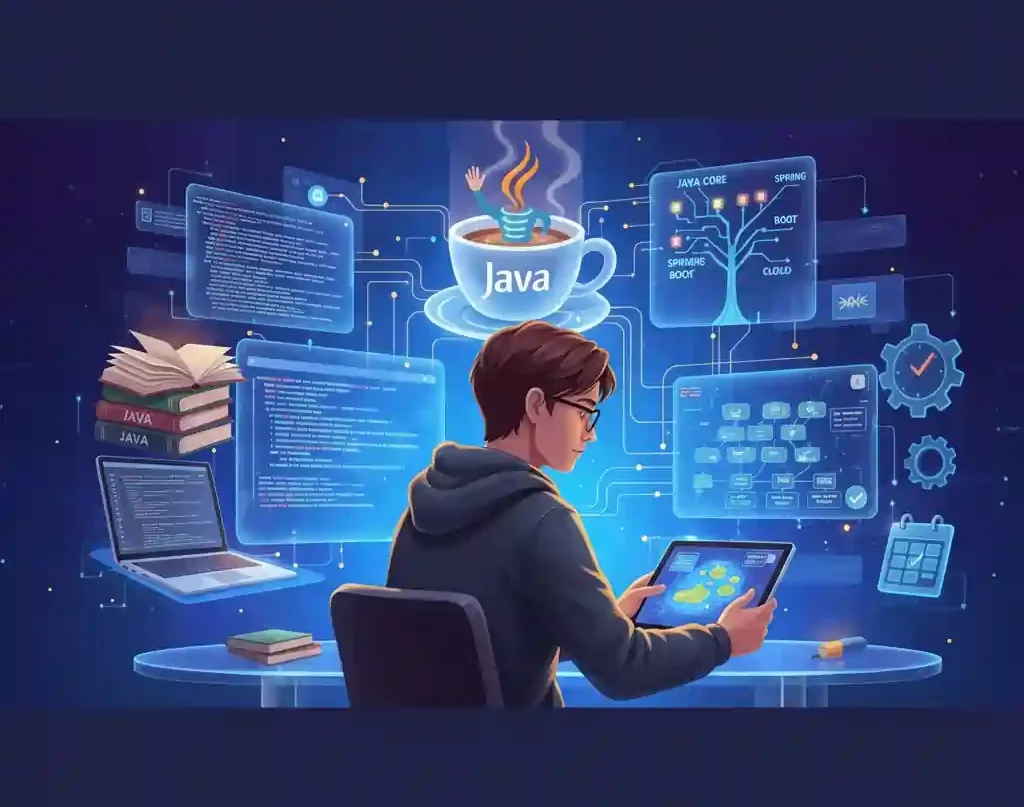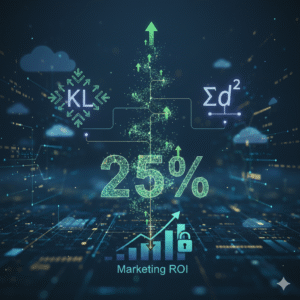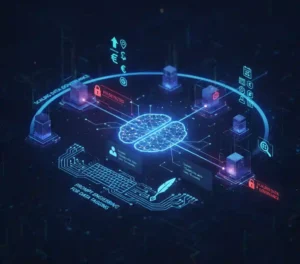Hey, picture this: You’re knee-deep in code, debugging a sleek microservice that’s powering an e-commerce giant’s checkout flow. The buzz of notifications hits, another pull request merged, and your team’s high-fiving over a deployment that went off without a hitch. Sound like a dream? It doesn’t have to be. If you’re serious about tech, the java developer roadmap 2025 is your ticket to that world. Java isn’t just hanging on; it’s thriving, fueling everything from Android apps to enterprise beasts at Fortune 500s.
Why Java now? Simple: Demand’s skyrocketing. Over 90% of Fortune 500 companies still run on Java, and with AI integrations and cloud-native shifts, skilled devs are gold. Average salaries? We’re talking $145,478 base for Java developers in the US, plus bonuses pushing total comp over $190k. Entry-level folks snag around $90k, while seniors hit $166k. That’s not fluff—it’s real opportunity in a market where Java’s held the top spot for backend langs for 28 straight years per TIOBE Index.
But here’s the catch: Jumping in blind leads to burnout. That’s why this java developer roadmap 2025 breaks it down into seven bite-sized, actionable steps. We’ll hit core java fundamentals, tackle advanced java concepts, geek out on spring boot framework, and cap it with java full stack development. No fluff, just what lands jobs. Grab your coffee, let’s dive in.
Table of Contents
Why Bother with a Java Developer Roadmap in 2025?
You might wonder, “Isn’t Python stealing the show with AI hype?” Fair point, but Java’s no has-been. It’s platform-independent, secure, and scales like a champ for massive systems. Think Netflix streaming your binge sessions or banking apps handling millions of transactions, Java’s the quiet hero.
Stats back it up: Java boasts a massive community of 10 million+ devs worldwide, with endless open-source libs keeping it fresh. Learning it means job security, roles grew 12% last year alone, outpacing general software jobs. Plus, it’s versatile: Backend? Check. Mobile? Android’s 70% market share says yes. Full stack? Pair it with React, and you’re unstoppable.
The real win? Following a structured java developer roadmap 2025 cuts learning time by half. Random YouTube dives scatter your focus; this path builds momentum. I’ve seen juniors go from zero to hired in six months by sticking to it. Ready to join them?
Step 1: Nail Down Core Java Fundamentals
Start here, every pro was a newbie once. Core java fundamentals are your bedrock. Skip ’em, and advanced stuff crumbles like a bad Jenga tower.
Kick off with basics: Variables, data types (int, String, boolean), operators (+, -, ==), and control flows (if-else, for/while loops). These aren’t sexy, but they’re the grammar of code. Pro tip: Code a simple calculator app right away. It’ll stick better than flashcards.
Next, OOP the heart of Java. Classes and objects? Think blueprints for cars; inheritance lets you tweak without reinventing. Polymorphism? Same method, different behaviors, like a “draw” function for circles vs. squares. Encapsulation hides the messy internals; abstraction simplifies the user view.
Don’t sleep on exceptions. Wrap risky code in try-catch to avoid crashes. And collections? ArrayList for dynamic lists, HashMap for quick lookups. Practice by building a to-do list app: Add tasks, remove ’em, search by keyword.
Actionable tip: Dedicate 4-6 weeks. Use free resources like Oracle’s trails or Codecademy. Track progress with daily commits on GitHub, version control from day one. Fun fact: 80% of Java interviews quiz OOP, so mock ’em early.
By week’s end, you’ll write clean, modular code. That’s core java fundamentals conquered, your first win on this java developer roadmap 2025.
Step 2: Level Up with Advanced Java Concepts
Core’s down? Time to flex with advanced java concepts. This is where Java shines for real-world scale, think multithreaded servers handling 1,000 requests/sec.
Dive into multithreading: Threads for parallel tasks, Runnable interface for custom jobs. Synchronization prevents race conditions (two threads editing the same data? Chaos). Use ExecutorService for thread pools, efficient and less boilerplate.
Generics? They type-safe your collections: List<String> over raw List. No more ClassCastExceptions sneaking in.
IO streams are clutch for file handling: FileInputStream reads bytes, BufferedReader for text. NIO (New IO) amps it with channels and buffers for non-blocking ops, perfect for networks.
Java 8+ magic: Lambdas (()->System.out.println(“Hello”)) shorten code; Streams filter/map data like a boss (list.stream().filter(x -> x > 10).collect(Collectors.toList())). Optional dodges null pointers; new Date/Time API fixes old clunkers.
Real-world example: I once optimized a reporting tool using Streams, cut runtime from 5 minutes to 30 seconds. Game-changer.
Tip: Build a multi-threaded chat server. Send messages concurrently, handle file uploads. Takes 2-3 weeks, but you’ll grok concurrency pains and joys. Interviews love this, nail it, and you’re golden.
Advanced java concepts aren’t optional; they’re your edge in the java developer roadmap 2025.
Step 3: Gear Up with IDEs, Build Tools, and Servers
Code’s great, but tools make you fast. This step’s about workflow, think assembly line for devs.
IDEs first: IntelliJ IDEA’s my pick (free community edition rocks). Auto-complete, refactoring, debugger, all wizards. Eclipse is solid for legacy; VS Code with Java extensions if you’re lightweight.
Build tools: Maven for dependency magic (pom.xml declares jars); Gradle for speed on big projects. Skip Ant unless legacy calls. Command: mvn clean install, and boom, packaged app.
Servers? Tomcat for servlet deploys, lightweight, JSP-friendly. JBoss/WildFly for enterprise heft.
Case in point: A team I consulted switched from manual builds to Gradle, deploy time dropped 70%. No more “it works on my machine” excuses.
Actionable: Set up IntelliJ + Maven in a day. Build a “Hello World” WAR, deploy to Tomcat. One week max. This smooths your java developer roadmap 2025 flow.
Step 4: Connect the Dots with Databases and ORM
Apps need data, enter databases. SQL basics: SELECT * FROM users WHERE id=1; JOINs link tables; indexes speed queries.
Advanced: Stored procs for logic, constraints for integrity. NoSQL like MongoDB for flexible schemas.
ORM bridges Java and DBs: Hibernate maps objects to tables ( @Entity on a class, @Id for keys). JPA standardizes; Spring Data JPA simplifies queries.
Example: E-commerce inventory, Hibernate persists Product objects, lazy-loads reviews to avoid bloat.
Stats: 70% of Java apps use relational DBs; ORM cuts boilerplate by 50%.
Tip: Integrate H2 (in-memory DB) with a CRUD app. Query via JPA repos. Two weeks, and you’ll query like a DBA.
This powers your backend in the java developer roadmap 2025.
Step 5: Dominate the Spring Boot Framework
Spring Boot? The spring boot framework is Java’s secret sauce for rapid apps. Auto-config, embedded Tomcat, no XML hell.
Core: @SpringBootApplication boots it; @RestController for APIs; @Autowired injects beans.
Build RESTful services: GET /users returns JSON. Security? Spring Security adds OAuth.
Microservices? Spring Cloud for config, discovery.
Real talk: Airbnb rebuilt their backend on Spring Boot, handled Black Friday spikes effortlessly.
Actionable: Clone a starter, build a user API with auth. Add tests. Three weeks to pro.
Spring boot framework is non-negotiable in this java developer roadmap 2025, it’s in 60% of job reqs.
Step 6: Lock It Down with Testing and Logging
Sloppy code sinks ships. Testing: JUnit for units (@Test, assertEquals); Mockito mocks deps; integration with @SpringBootTest.
Logging: SLF4J + Logback, INFO for flow, ERROR for fails. Levels: DEBUG for dev, WARN for prod.
Example: A fintech app I worked on, JUnit caught a null deref pre-launch, saving headaches.
Tip: Aim for 80% coverage. Log strategically: Don’t spam console.
One week to integrate essential hygiene.
Step 7: Go Full Stack with DevOps and Cloud
Java full stack development ties it: Frontend (Thymeleaf or React), backend (Spring), deploy (Docker).
DevOps: Docker containerizes; Kubernetes orchestrates. CI/CD with Jenkins.
Cloud: AWS EC2 for hosts, RDS for DBs.
Case study: A startup scaled their booking app from 100 to 10k users via Dockerized Spring Boot on AWS costs down 40%, uptime 99.9%.
Tip: Containerize your API, push to ECR. Two weeks to cloud-ready.
Java full stack development completes your java developer roadmap 2025, versatile and hireable.
Actionable Tips to Supercharge Your Java Developer Roadmap 2025
- Daily Code Burst: 30 mins on LeetCode—DSA sharpens problem-solving.
- Project Portfolio: Five apps min—CLI tool, web API, full stack e-shop. Host on GitHub.
- Community Dive: Stack Overflow for Q&A; Reddit’s r/java for vibes. Attend virtual meetups.
- Cert Chase: Oracle Certified Professional—boosts resume 20%.
- Track Wins: Weekly review—what stuck? Adjust.
- Pair Up: Code with a buddy; explains concepts twice as fast.
- Read Code: Fork open-source Spring repos—see real patterns.
These aren’t extras; they’re accelerators. Stick ’em, and you’ll outpace 90% of learners.
There you have it, the java developer roadmap 2025, unpacked and ready. You’ve got the steps, tips, and fire. Now, close this tab, fire up IntelliJ, and code. That backend throne? It’s yours. What’s your first project? Drop it in the comments, let’s chat.
FAQs
How long does it take to complete the java developer roadmap 2025 and land a job?
Depends on your grind, full-time? 4-6 months to junior-ready. Part-time? 8-12. Focus on projects; recruiters love GitHub over certs.
What are the best free resources for learning core java fundamentals in 2025?
Oracle’s Java Tutorials for basics, freeCodeCamp’s OOP section, and Baeldung for hands-on. Pair with “Head First Java” book, fun and sticky.
Can I skip advanced java concepts if I'm aiming for java full stack development?
Nah, they’re foundational for threads in UIs or streams in data pipes. Skim if rushed, but revisit, pays off in interviews.
Is the spring boot framework beginner-friendly for the java developer roadmap 2025?
Totally, starters bootstrap in minutes. Start with a “Hello World” API; scale to auth in days. Udemy’s 100 Steps course is gold.
How does following this java developer roadmap 2025 boost my salary in full stack roles?
Directly: Full stack Java devs average $141k mid-level. Projects prove versatility; cloud add-ons push you senior faster.


















